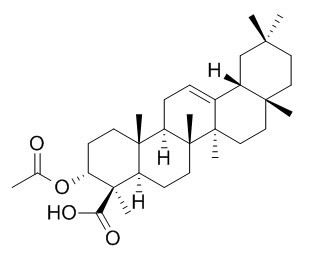3-O-Acetyl-alpha-boswellic acid
3-O-Acetyl-alpha-boswellic acid has strong anti-inflammatory activity.
Inquire / Order:
manager@chemfaces.com
Technical Inquiries:
service@chemfaces.com
Tel:
+86-27-84237783
Fax:
+86-27-84254680
Address:
1 Building, No. 83, CheCheng Rd., Wuhan Economic and Technological Development Zone, Wuhan, Hubei 430056, PRC
Providing storage is as stated on the product vial and the vial is kept tightly sealed, the product can be stored for up to
24 months(2-8C).
Wherever possible, you should prepare and use solutions on the same day. However, if you need to make up stock solutions in advance, we recommend that you store the solution as aliquots in tightly sealed vials at -20C. Generally, these will be useable for up to two weeks. Before use, and prior to opening the vial we recommend that you allow your product to equilibrate to room temperature for at least 1 hour.
Need more advice on solubility, usage and handling? Please email to: service@chemfaces.com
The packaging of the product may have turned upside down during transportation, resulting in the natural compounds adhering to the neck or cap of the vial. take the vial out of its packaging and gently shake to let the compounds fall to the bottom of the vial. for liquid products, centrifuge at 200-500 RPM to gather the liquid at the bottom of the vial. try to avoid loss or contamination during handling.
Nutrients.2017, 10(1)
Jeju National University Graduate School2023, 24478
Korean J. of Food Sci. and Tech2016, 172-177
Inflammation.2015, 38(4):1502-16
Molecules.2022, 27(22):7887.
New Journal of Chemistry2019, 43:12538-12547
Pharmaceuticals (Basel).2024 Feb 24;17(3):292.
Vietnam Journal of Food Control2022, 5(3):pp.390-401.
Phytochem Anal.2023, pca.3305.
J Sep Sci.2018, 41(11):2488-2497
Related and Featured Products
Cancer Research, 2005 , 65 :176-176.
Inhibitory effects of beta-boswellic acids on 12-O-tetradecanoylphorbol-13-acetate-induced inflammation, expression of pro-inflammatory cytokines, arachidonic acid metabolism, and tumor promotion in mouse skin[Reference:
WebLink]
Boswellia serrata extracts have been used for centuries as an herbal medicine for the treatment of inflammation and related diseases in India and China.
METHODS AND RESULTS:
A preparation of Boswellia extract (BE) contains about 35-40% total beta-boswellic acids and further separated and purified by a Phenomenex Synergi MAX-RP 80A column into 6 peaks. Four peaks were identified as beta-boswellic acid, 3-O-acetyl-beta-boswelic acid, 11-keto-beta-boswellic acid and 3-O-acety-11-keto-beta-boswellic acid, respectively. The other 2 peaks were alpha-boswellic acid and 3-O-Acetyl-alpha-boswellic acid . Beta-boswellic acid and its 3 derivatives had strong anti-inflammatory activity in mouse ear edema test. Topical application of TPA (0.8 nmol) onto ears of CD-1 mice once a day for 4-5 days induced persistent inflammation that was corrected with elevated protein levels of pro-inflammatory cytokines as well as formation of PGE2 and LTB4 levels in the mouse ears.
CONCLUSIONS:
Topical application of BE and pure beta-boswellic acid at 30 min before each TPA application once a day for 4 days inhibited TPA-induced persistent inflammation and expression IL-1beta and IL-6 protein levels as well as inhibited formation of LTB4 levels, but not PGE2 levels in mouse ears.
J Chromatogr A. 2004 Jan 16;1023(2):277-85.
Characterization of archaeological frankincense by gas chromatography-mass spectrometry.[Pubmed:
14753694]
METHODS AND RESULTS:
A simple gas chromatography-mass spectrometry (GC-MS) method has been developed for the characterization of frankincense in archaeological samples. After trimethylsilylation of the methanolic extract, 15 triterpenoids have been found among the chemical constituents of commercial olibanum (alpha-boswellic acid, 3-O-Acetyl-alpha-boswellic acid , beta-boswellic acid, 3-O-acetyl-beta-boswellic acid, alpha-amyrin, beta-amyrin, lupeol, 3-epi-beta-amyrin, 3-epi-beta-amyrin, 3-epi-lupeol, alpha-amyrenone, beta-amyrenone, lupenone, 3alpha-hydroxy-lup-20(29)-en-24-oic acid and 3-O-acetyl-hydroxy-lup-20(29)-en-24-oic acid). These compounds have been unequivocally identified by retention time and mass spectral comparison with pure standards previously isolated, for the most part, in our laboratory. Within these triterpenes, acid ones, the corresponding O-acetates, and their products of degradation were found to be characteristic of frankincense (Boswellia resin).
CONCLUSIONS:
The presence of these unusual triterpenic compounds in an archaeological resinous sample, recovered during excavations from Dahshour site (Egypt, XIIth Dynasty), enabled us to identify unambiguously frankincense resin among several other materials. Additional chromatographic peaks of this sample were assigned to broad chemical classes using retention time and mass spectra features.



